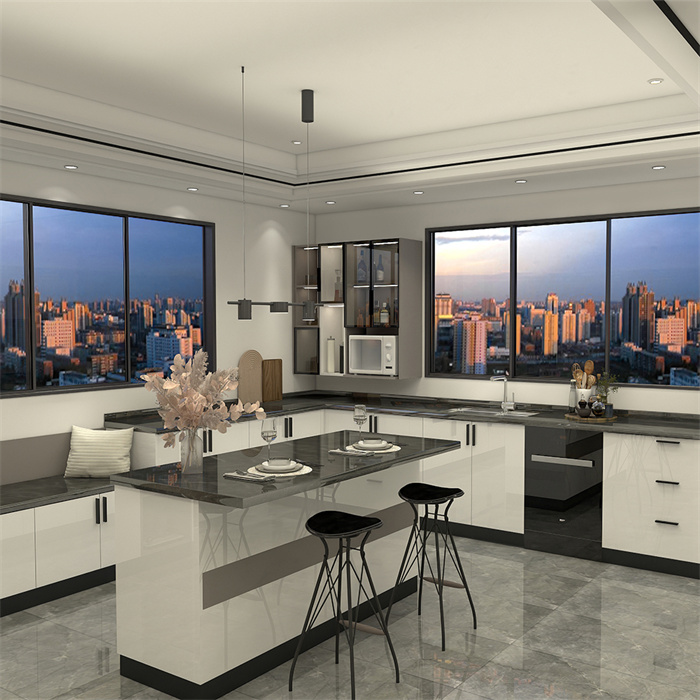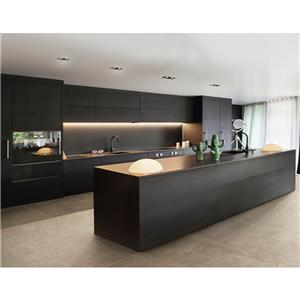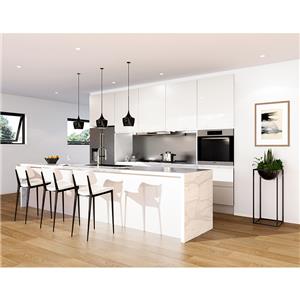Can't seem to keep those bottles and jars on the worktop tidy?
Can't seem to keep those bottles and jars on the worktop tidy? Scientific storage methods will leave your kitchen counter looking as good as new.
Having just put the soy sauce and vinegar bottles back in their places, the next day the worktop is once again piled high with condiment jars and oil cans; to chop vegetables, one must first move three or four bottles aside to make room for the chopping board. This is the daily frustration faced by Ms Zhao, a homeowner in Xi'an, and reflects the reality in 78% of households. A home industry survey reveals that countertops in kitchens experience a ‘clutter recurrence rate’ exceeding 80%, with jars and bottles occupying 30-50% of counter space. This not only detracts from the kitchen's aesthetic appeal but also reduces cooking efficiency by 35% and increases daily cleaning time by 23 minutes. In truth, the difficulty in organising countertop bottles and jars stems not from ‘laziness’ or ‘limited space,’ but from a lack of scientific categorisation logic and suitable tools. This article, in collaboration with seasoned organisers and cabinet designers, will guide you through three common misconceptions, a four-step categorisation method, five recommended tool types, and three practical scenario solutions. Together, we'll help you bid farewell to the ‘bottle siege’ and achieve lasting tidiness on your kitchen countertops.
I. Why Do Bottles and Jars Always End Up in Chaos? Debunking 3 Hidden Pitfalls
1. Categorisation chaos: “Mixed storage” leads to “difficulty in returning items to their place”, resulting in four times lower efficiency.
‘All condiments are jumbled together in one tray. When using them, you rummage through everything, then casually toss them back afterwards. Naturally, the countertop becomes cluttered quickly,’ notes certified organiser Liu Min, pointing out that 90% of households suffer from “vague categorisation of bottles and jars”. Mr Li's Beijing kitchen exemplifies this: soy sauce, cooking wine, salt and sugar are haphazardly stored together, while bean paste and chilli sauce lie scattered in corners. Even a tomato sauce bottle, forgotten for six months past its expiry date, remains untouched. ‘Finding condiments takes five minutes each time I cook,’ he laments. ‘After use, it's too much trouble to return them, so within three days it's back to square one.’
A 14-day test by a storage laboratory revealed stark contrasts: in disorganised households, only 32% of containers were returned after use, with an average of 4.8 minutes spent daily searching for condiments. Conversely, households with clear categorisation achieved an 89% return rate, reducing the search time to just 1.2 minutes. Liu Min explains: ‘When jars have “designated spots” and retrieval/return requires just one action, habits form naturally. Otherwise, haphazard storage traps you in a “searching makes it messier” cycle.’
2. Mismatched tools: ‘Unsuitable tools’ are worse than ‘no tools at all’
‘I bought a trendy spice rack on impulse, only to find my soy sauce bottle too tall to fit. Storing salt in plastic containers meant it spilled out every time I pulled the drawer.’ Ms Chen from Guangzhou's experience is commonplace. Liu Min's team tested 100 storage solutions and found 62% had ‘usage pain points’:
Prioritising aesthetics over dimensions: Fixed-height shelves cannot accommodate oil bottles over 15cm tall;
Overemphasising ‘capacity’: 12-compartment storage boxes only reveal 4 compartments, with the rest obscured;
Ignoring usage scenarios: Fabric boxes near the hob become greasy, increasing cleaning frequency from weekly to daily;
Substandard materials: Cheap plastic hooks snapped under the weight of two jars, posing safety hazards.
‘Unsuitable tools become new clutter, making countertops messier and wasting money,’ emphasised Liu Min.
3. Wasted space: Vertical + concealed areas left unused, squandering 1.2m²
‘Focusing solely on countertops overlooks “hidden spaces” like walls and drawers,’ Kitchen designer Zhang Wei notes that in compact 6-8m² kitchens, vertical space (walls, wall cabinets) and hidden storage (drawers, deep base units) utilise less than 30% of potential capacity—equivalent to squandering 1.2-1.5m² of space. This area could accommodate 20-30 additional bottles and jars.
Ms Zhou's Shanghai renovation exemplifies this shift: pre-renovation, 12 bottles occupied 1.2m² of worktop, forcing her to rearrange containers while chopping. Post-renovation, four bottles hang on walls, five reside in drawers, and three are concealed in wall units, leaving only two frequently used containers on the worktop. ‘Now the worktop comfortably holds both chopping board and wok simultaneously—no more cramming.’
Data indicates that households optimising vertical storage reduce countertop jar occupancy to under 15%, increasing workspace by 40%. ‘The countertop's primary function is “preparation”, not “storage”. Relocating jars to alternative spaces ensures lasting tidiness,’ explains Zhang Wei.

II. 4-Step Scientific Classification: Assigning Each Jar and Can Its 'Designated Place'
1. Categorised by usage frequency: 3-tier organisation system, achieving an 89% improvement in return rate.
First, consolidate all bottles and jars. Categorise them as ‘Daily use’, ‘2-3 times weekly’, or ‘Less than monthly’, labelling each with sticky notes:
Frequently used items (salt, oil, soy sauce, vinegar): Place in the ‘within arm's reach’ zone (height 1.2-1.5m, 10-20cm from the work surface), such as a rotating rack beside the hob or a magnetic wall rack. Mr Li from Beijing hangs salt and sugar on a magnetic rack above his hob: ‘I can grab them while stir-frying and put them back immediately afterwards – very convenient’;
Semi-frequent use (cooking wine, sesame oil, pepper):
Store in the ‘slightly elevated reach zone’ (1.5–1.8m or 0.8–1.2m), such as pull-out drawers beneath worktops or lower wall cabinet shelves. Ms Zhou keeps cooking wine and sesame oil in a pull-out drawer: ‘Push it back after use—it vanishes from the worktop’;
Low-frequency use (spices, tomato sauce): Store in the ‘reserve zone’ (above 1.8m or below 0.8m), such as pull-down baskets in wall cabinets or refrigerator shelves. Ms Zhao from Xi'an stores spices in airtight jars within a wall cabinet pull-down basket, ‘accessible with a simple pull-down motion, eliminating the need for a step stool’.
Testing revealed that this categorisation increased the return rate from 32% to 89% and reduced seasoning retrieval time by 75%.
2. Categorised by form: 3 types of adapters to prevent difficult retrieval
Different container forms demand distinct approaches, necessitating further classification:
Liquids (soy sauce, oil): Leak-proof, easy to pour, kept away from heat sources. Use countertop racks with dividers (to prevent collisions and spills), wall-mounted oil bottle holders (space-saving), positioned at least 30cm from the hob to prevent spoilage. Mrs Chen uses a rack with grooves: ‘The bottles sit securely, and I've never spilled soy sauce again’;
Solids (salt, sugar, flour): Moisture-proof sealing, easy access. Use drawer dividers with silicone lids (prevents clumping), transparent airtight containers (easy identification), and perforated shakers (controlled dispensing). Ms Zhao stores salt in a moisture-proof container: ‘It doesn't clump for a whole month’;
Pastes (chilli bean paste, salad dressing): Easy to scoop, prevent contamination, and preserve freshness. Use airtight jars with dedicated spoons (avoid contamination from chopsticks), silicone squeeze bottles (minimise residue), and store in the refrigerator's 0-4°C compartment during summer. A testing agency revealed that leaving bean paste at room temperature for 7 days triples bacterial growth, whereas refrigeration extends shelf life to over 30 days. Mrs Zhou stores sauces in the refrigerator door, noting it's ‘clean and protects against grease stains.’
3. Organised by usage scenario: 3-zone layout boosts workflow efficiency by 62.5%
Following the cooking workflow, place jars and bottles where they're most accessible during use:
By the hob: Store salt, oil and soy sauce for stir-frying within 10-20cm of the hob – ‘no need to turn or bend’. Mr Li hangs his salt shaker to the left of the hob and places soy sauce to the right—‘left hand for salt, right hand for soy sauce; return them to their places after cooking.’
Sink area: Store vinegar, sesame oil, and salad dressing for cold dishes—‘season straight after washing produce.’ Mrs Chen keeps vinegar and sesame oil in a lidded container beside the sink—‘no need to dash to the hob; cover them after use to keep dust out.’
Prep area: Holds pepper and chilli powder for chopping, positioned near the chopping board. Ms Zhao installed a two-tier wall shelf in the prep zone, ‘so ingredients are within arm's reach while chopping, freeing up counter space.’
Zhang Wei's team found that this scenario-based layout reduced the ‘retrieve-use-return’ cycle from 8 to 3 seconds, boosting efficiency by 62.5%.
4. By capacity: Three sizes adapt to increase space utilisation by 50%
Large capacity (5L oil, 10kg rice, 1L soy sauce): Store on the floor or in base cabinets (to prevent tipping), such as a base cabinet oil drum rack (with castors for easy pulling out to pour oil). Ms Zhao placed her 5L oil in the base cabinet rack, noting, ‘No lifting required, pouring oil is very convenient.’ Medium capacity (500ml soy sauce, 250ml cooking wine):
Store on mid-level counter shelves or drawer compartments (‘won't obstruct frequently used jars’). Mr Li placed soy sauce and vinegar on a mid-level rotating rack (‘no bending over when retrieving, and doesn't block upper shelves’).
Small capacity (100g salt, 50g pepper): Use compartmentalised boxes and mini hooks for centralised storage, ‘to prevent loss’. Mrs Zhou uses mini boxes for small jars, ‘opening the drawer reveals everything at a glance, without being blocked by larger containers’.
Following this categorisation, the 8m² kitchen worktop utilisation rate increased from 50% to 75%, accommodating 6 additional bottles and jars without feeling cramped.
III. 5 Essential Organising Tools: Choose the Right Tools for Effortless Tidying
1. Worktop tools: Space-saving and easy access
Rotating tiered rack: 360° rotation, diameter 25-30cm. Fits corners without encroaching on core space, accommodates frequently used jars. Mr Li uses it for soy sauce and vinegar: ‘Just give it a spin to grab what you need – very convenient.’
Compartmentalised storage box: Transparent design for easy identification, with handles for convenient cleaning. Secures liquid bottles to prevent spills. Mrs Chen uses it for vinegar and sesame oil, noting, ‘Bottles stay steady, and it lifts away for cleaning’;
Foldable rack: Collapses for storage, unfolds for syrup and honey during meal prep, ideal for compact kitchens. Mrs Zhao keeps one in her prep area, remarking, ‘It doesn't take up space normally, yet provides just enough space for baking.’
2. Wall-mounted tools: Free up counter space with stylish solutions
Magnetic racks / hooks: No drilling required for tiled walls. Ideal for hanging metal tins and glass jars of condiments near the hob. Mr Li uses them for salt and sugar containers, noting ‘the countertop suddenly feels half as cluttered’;
Multi-tier wall rack: 2-3 adjustable tiers with safety rails to prevent items falling. Mounted near sinks or prep areas. Ms Zhou installed a two-tier rack in her prep zone: ‘Holds pepper and chilli powder without obstructing chopping.’
3. Drawer organisers: Concealed storage, grease-proof
Divider boxes: Freely configurable compartments with lids to prevent moisture, ideal for storing solid seasonings. Mrs Zhao uses them for salt and sugar: ‘Each has its own compartment, no spills or leaks’;
Lift-and-slide baskets: The basket slides vertically, allowing access to bottom jars without moving upper ones. Installed in drawers beside the hob. Ms Chen uses it for cooking wine, noting, ‘Bottles at the back were previously blocked; now I simply lift to access them’;
Side-Mounted Rack: Holds slender bottles (sesame oil, vinegar) without occupying drawer floor space; adjustable width fits various drawers. Ms Zhou hangs three bottles of sesame oil, stating, ‘The drawer floor remains free for other utensils’.
4. Cabinet Organisation Tools: Accessing Depths, Storing Low-Frequency Containers
Wall Cabinet Lift-Out Basket: Pull down to retrieve high-shelf containers. Holds up to 5kg. Ideal for spices and infrequently used sauces. Mrs Zhao uses it for star anise and bay leaves: ‘No need to stand on a stool – safe and convenient.’
Base cabinet rotating pull-out basket: 360° rotation accesses deep-set large containers (oil drums, rice bins), with dividers to prevent collision. Mr Li uses it for his 5L oil drum, remarking, ‘Used to take ages to retrieve it; now just a turn and it's at the door.’
5. Portable Tools: Multi-scenario Adaptability
Handheld Condiment Box: Features built-in dividers and a convenient handle for easy movement, ideal for transferring between the prep area and dining table. Ms Zhou uses it for salad dressings, noting, ‘After use in the kitchen, I simply carry it to the table without constant trips back and forth.’
Refrigerator Side Door Organiser: Mounted on the refrigerator door, the transparent design allows easy identification. Features drainage holes to prevent condensation and stores sauce bottles. Ms Chen uses it for storing bean paste, noting, ‘It doesn't take up fridge space and is easy to access.’
IV. 3 Major Scenario Solutions: Adaptable to Different Layouts, Ready to Use Out of the Box
1. Compact Kitchens (5-8m²): Vertical + Concealed Storage Solutions
Worktop: Reserve one rotating rack for two frequently used containers;
Wall Space: Install magnetic racks beside the hob and wall-mounted shelves in the prep area;
Drawers: Use dividers + side-mounted racks for less frequently used containers;
Cabinets: Lift-up pull-out baskets in wall units for infrequently used containers; rotating racks in base units for large oil drums.
Following the renovation of Ms Zhao's 6m² linear kitchen in Xi'an, countertop containers were reduced from 12 to 2. ‘Now there's no crowding when chopping or stir-frying – cooking feels much more pleasant.’
2. Medium-sized units (9-12m²): Zoned storage + Flexible aesthetics
Divide storage into cooking, sink and prep zones using uniform accessories (e.g. metal racks + transparent containers);
Reserve 2-3 decorative storage boxes on the worktop for frequently used jars;
Organise drawers/cupboards by tier, with one portable box for versatile scenarios.
Mr Li's 10m² L-shaped kitchen in Beijing: ‘Neat and attractive – friends always compliment it.’
3. Large-format kitchens (13m²+): Functionality + Display Integration
Dedicated condiment zone: Create a ‘condiment wall’ using wall-mounted racks + transparent jars for both storage and decoration;
Island counter: Fit pull-out baskets in drawers for frequently used jars, facilitating multi-person meal prep;
Storage area: Convert base units into a ‘spice cabinet’ with rotating racks and dividers for infrequently used jars.
Ms Zhou's 15m² U-shaped kitchen in Shanghai: ‘The spice wall has become the kitchen's highlight, delivering both storage and visual appeal.’
V. Long-Term Maintenance: Three Habits to Keep Your Worktop ‘Permanently Tidy’
1. Regular decluttering: Once a month
Sort through jars and containers monthly, discarding expired or rarely used items (such as spices untouched for a year) to prevent accumulation. ‘Expired condiments not only take up space but may also affect health,’ advises Liu Min.
2. Return items to their place immediately after use: Develop muscle memory
Whilst cooking, promptly return used jars and containers to their designated spots rather than waiting for a final tidy-up. ‘Immediate return is easier than batch organisation and prevents countertops from becoming cluttered again,’ notes Liu Min.
3. Weekly light cleaning: 5 minutes to maintain
Wipe down storage tools and jar surfaces with a damp cloth once a week to prevent grease build-up. ‘Small clean-ups are less labour-intensive than monthly deep cleans and keep surfaces fresh,’ adds Zhang Wei.
Conclusion: Small changes, big difference
Countertop clutter isn't down to ‘limited space’ or ‘laziness’ – it's simply a matter of using the wrong approach. Through scientific categorisation, selecting the right tools, and maximising vertical storage, even a 5m² kitchen can achieve a clutter-free countertop. As Ms Zhao from Xi'an remarked: ‘Cooking used to feel like a battle, but now it's far more composed — who knew such small changes could make such a big difference to the kitchen?’
If you too are troubled by jars and bottles, why not start by ‘categorising items by usage frequency’? Take it step by step, and you too can achieve a refreshingly clear kitchen countertop!
How to buy kitchen cabinets? ➡
Exclusive Interview with Homeowner ➡
Struggling to turn around in your kitchen? ➡
Is the trend towards "de-living-rooming" design catching on? ➡




